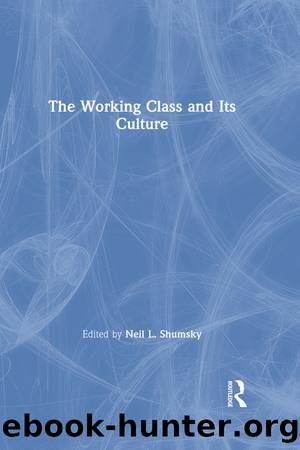The Working Class and Its Culture by Neil L. Shumsky

Author:Neil L. Shumsky [Shumsky, Neil L.]
Language: eng
Format: epub
ISBN: 9781135603892
Barnesnoble:
Publisher: Taylor & Francis
Published: 2019-10-23T00:00:00+00:00
IV
Throughout the strike and boycott, newspapers reported no acts of violence by Progressives. Immigrants soon learned, however, that boycotts were regarded by ârespectableâ citizens as violently intimidating and un-American. The first warnings came in early fall, 1885. A Jefferson City, Missouri, grand jury was investigating a recent railroad strike and boycott in the area. âBoycotting May Be Illegal,â Swintonâs headline read. The judgeâs charge to the jury indicated that more was involved than a question of the boycottâs legality. âA system and name foreign to our institutions and language, known in Ireland as boycottingâ the judge said, âis sought to be introduced among us as a means of compelling concessions in matters of conflicting interests.â Combinations which tried to further the interests of their members were lawful. âBut if the object of the combination is, or embraces the necessary effects of which is interfering with othersâ rights, the combination becomes a conspiracy, and may be dealt with as such.â61
The exact meaning of âconspiracyâ was defined in New York City courts in 1886, when roughly one hundred members of labor organizations were indicted on that and related charges in connection with strikes and boycotts. Only a few of these cases can be examined here. Understandably, bakers were among those waging the most numerous boycotts. âThe bakerâs trade,â the Bureau of Labor Statistics commented in 1886, âis one in which the unreasonably long hours, the poor pay and great privation have justified the menâs attempts to better their condition.â These conditions were the subjects of two letters written to John Swintonâs Paper by New York baker Michael McGrath. The cityâs bakers, McGrath wrote in December 1883, worked up to sixteen hours a day. âOur trade is the worst trade in New York,â he complained. Some journeymen bakers made as little as eight dollars a week under horrible conditions, while employers made heavy profits. McGrath described a tragic situation eight months later. Four German bakers had committed suicide, the causes of which McGrath attributed to degrading working and living conditions common to recently-arrived German immigrants. German employers could hire a baker from Castle Garden for a dollar a week. On such inadequate wages, he explained, the men were forced to live in the bakery, where leakage, poor sewerage, and gasses and steam from ovens made life unbearable. âThese men have to work on an average of sixteen hours per day down in those poisonness [sic] cellars breathing that foul air, and it is nothing unusual to look around our beds and see the rats running about making fun as it were of our miserable surroundings.â âIs it any wonder,â he concluded, âthey commit suicide?â62
The large number of neighborhood bakeries made union shops essential if bakers were to improve these conditions. The German Bakersâ Union No. 1, an affiliate of the National Bakersâ Union, adopted a policy limiting a dayâs work to twelve hours on weekdays, and fourteen on Saturdays. Walking delegates were instructed to investigate bakery working conditions and to determine if shops were unionized.
Download
This site does not store any files on its server. We only index and link to content provided by other sites. Please contact the content providers to delete copyright contents if any and email us, we'll remove relevant links or contents immediately.
| Anthropology | Archaeology |
| Philosophy | Politics & Government |
| Social Sciences | Sociology |
| Women's Studies |
Nudge - Improving Decisions about Health, Wealth, and Happiness by Thaler Sunstein(7261)
iGen by Jean M. Twenge(5166)
The Fire Next Time by James Baldwin(5025)
Adulting by Kelly Williams Brown(4241)
The Hacking of the American Mind by Robert H. Lustig(4093)
The Sports Rules Book by Human Kinetics(4081)
The Ethical Slut by Janet W. Hardy(4042)
Captivate by Vanessa Van Edwards(3732)
Mummy Knew by Lisa James(3523)
In a Sunburned Country by Bill Bryson(3376)
The Worm at the Core by Sheldon Solomon(3328)
Ants Among Elephants by Sujatha Gidla(3282)
Suicide: A Study in Sociology by Emile Durkheim(2908)
The Slow Fix: Solve Problems, Work Smarter, and Live Better In a World Addicted to Speed by Carl Honore(2843)
The 48 laws of power by Robert Greene & Joost Elffers(2818)
Humans of New York by Brandon Stanton(2694)
Handbook of Forensic Sociology and Psychology by Stephen J. Morewitz & Mark L. Goldstein(2606)
The Happy Hooker by Xaviera Hollander(2586)
The Tipping Point by Malcolm Gladwell(2565)
